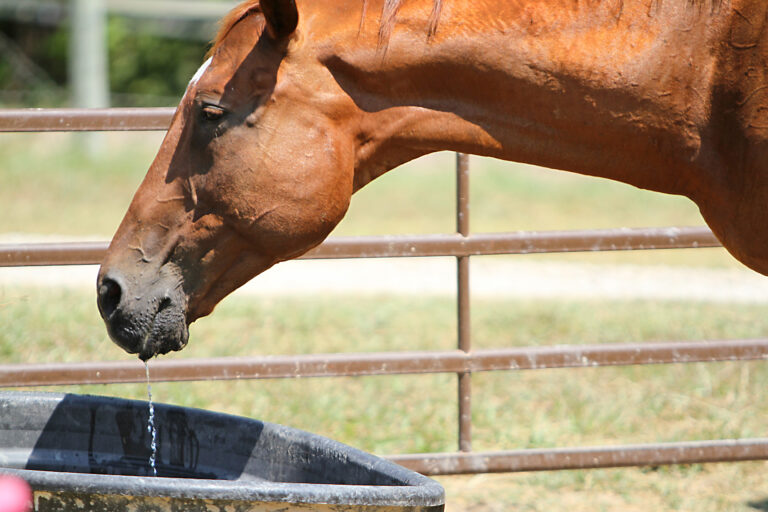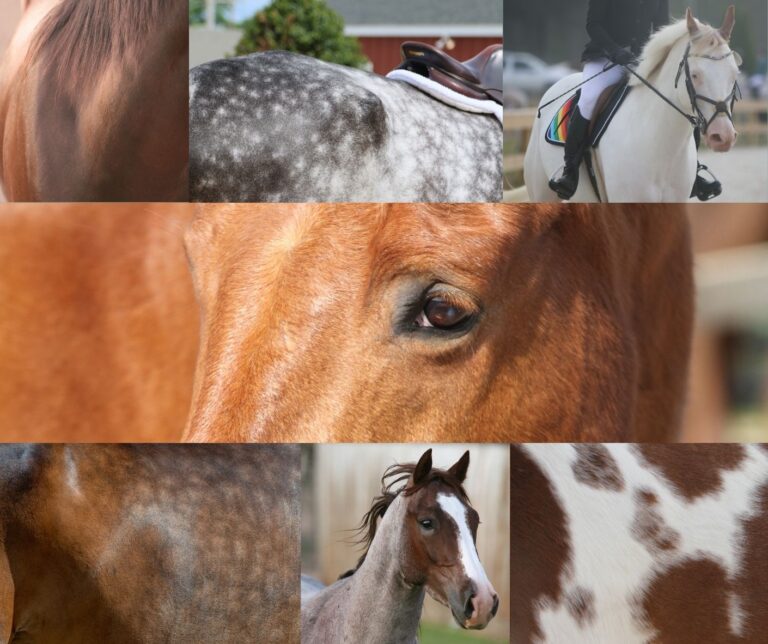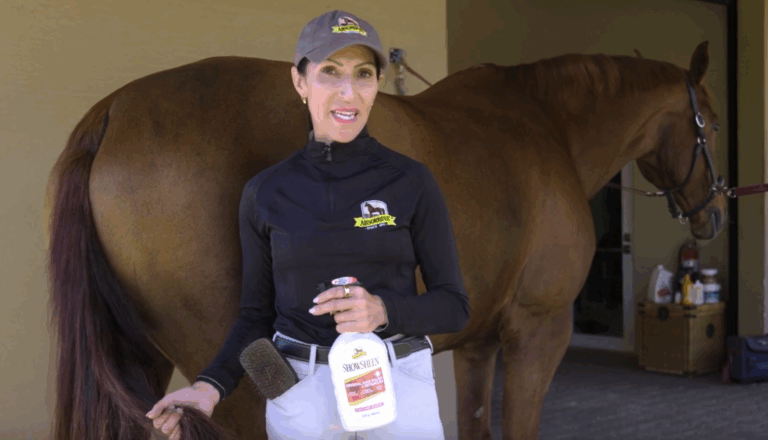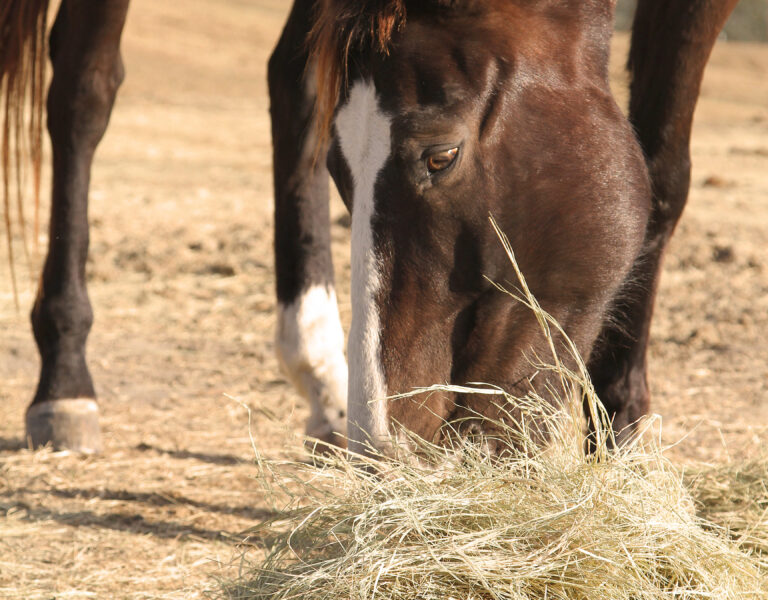
Horse owners inherently feel peaceful listening to their horse softly breathing while munching hay or feeling their warm blowing on our cheek when saying hello. Likewise, we get a thrill out of watching a grand prix show jumper turn and burn in a jump-off or a four-star event horse power down the galloping lane, nostrils flaring. For all these actions to occur, a complex respiratory system functions to take in oxygen and fuel the body’s many processes.
The equine respiratory system is built for transferring large volumes of air in and out of the lungs during exercise. It can be separated into two parts, the upper and lower airways. The upper airway begins at the nostrils, extends through the larynx and into the trachea. The lower airway includes the massive lungs, which extend from underneath the shoulder muscle up the back and close to the far end of the rib cage. A normal horse will take around 12 breaths per minute at rest, but his respirations may reach more than 100 breaths per minute during strenuous exercise.
Several types of physical malfunctions, infections and diseases can negatively impact the effectiveness of the respiratory system. Many of them can be treated through medication or prevented with vaccinations, but the number-one method of managing your horse’s respiratory health is providing a clean, healthy living environment.
Upper-Airway Disease: Hear It Roar
Several diseases of the upper airway may cause respiratory noises due to obstruction of the airway. Laryngeal hemiplegia is a disease common in Thoroughbred racehorses, but no breed is immune. This condition is often referred to as “roaring” because of the characteristic noise made during exercise. Laryngeal hemiplegia affects the larynx, which Lisa Fultz, DVM, MS, DACVIM, an internal medicine specialist from Equine Medicine Specialists of South Florida, describes as the “pair of swinging doors” that open and close the windpipe. It allows air to pass through but stops food or liquid, which normally enters the esophagus, from infiltrating the airway. With laryngeal hemiplegia, one or both sides of the larynx (called the vocal folds or arytenoid cartilages) is paralyzed so that it opens slowly or not at all, which may reduce airflow and create respiratory noise. It is one of the most common upper-respiratory tract diseases that affects performance, but what causes the disease is unclear.
“A lot of the time we don’t know it is occurring until the horse experiences noise when he’s exercising or gives a poor performance,” Dr. Fultz says. “Some are not 100 percent paralyzed; there are different degrees of weakness [graded on a scale of 1–4]. ”
The primary concern with laryngeal hemiplegia is whether or not the horse is getting plenty of airflow. If the larynx is paralyzed and cannot fully open to transfer air in and out of the windpipe, the horse’s breathing may become labored during high-intensity exercise.
Two commonly used treatment options are available to horses with laryngeal hemiplegia: ventricular cordectomy and prosthetic laryngoplasty (also known as tie-back surgery). A ventricular cordectomy is a procedure in which the veterinarian uses a scope and laser on a standing horse to ablate, or remove, the affected part of the larynx and widen the airway. Tie-back surgery is a permanent procedure performed under general anesthesia that will secure the larynx in an open position, eliminating the roaring and increasing airflow.
Tie-back surgery is a popular treatment option, but may cause complications due to the now perpetually open “door” to the lungs. After tie-back surgery, there is an increased risk of bacteria reaching the lungs and causing illness as well as aspiration pneumonia, an infection caused by inhaling food or liquids.
Another condition known as epiglottic entrapment may also cause respiratory noise and exercise intolerance. This occurs when the loose skin of the epiglottis, a piece of cartilage attached to the entrance of the larynx, flips up and sits over the top of the epiglottis. This will not always cause a decrease in performance, but it may be surgically corrected if necessary.
One more upper respiratory issue involves the horse’s soft palate. The structure of the horse’s air passages is such that the soft palate forms a seal below the larynx so that the processes of eating and breathing are completely separated. However, sometimes the soft palate can become displaced over the epiglottis and can cause respiratory noise and decreased performance due to the obstruction of the airway. Dorsal displacement of the soft palate may be treated with rest and anti-inflammatory drugs or surgery in severe, recurrent cases.
Lower-Airway Disease: Equine Asthma
In 2016, the American College of Veterinary Internal Medicine agreed to classify certain respiratory diseases in the lower- respiratory tract under the blanket term “equine asthma” due to the similarities to symptoms that occur in asthmatic people, including chronic inflammation in the airways and difficulty breathing. Equine asthma occurs when the lungs’ immune system becomes overactive, causing spasms and damaging the horse’s ability to breathe. Two diseases now recognized as equine asthma are inflammatory airway disease and recurrent airway obstruction, also known as “heaves.”
The first, IAD, is typically found in young horses but can affect horses of any age. It is characterized by decreased performance, excess mucus in the airway and sometimes cough. Horses with IAD will seem otherwise healthy with a good appetite, normal bloodwork and no fever, but they suffer what Dr. Fultz calls a “mild, localized inflammatory response to their environment that most owners only notice” during exercise. The exact cause of this disease is not known, but it is treatable through medication and controlling environmental stimulants.
In contrast, RAO, a chronic, serious condition most common in horses over 7 years old, is nonreversible. As with IAD, horses suffering from RAO will have excess mucus in the airway. However, a horse suffering from heaves will have difficulty breathing even at rest, coughs frequently and is exercise-intolerant, which means he may be having difficulty with what is being asked of him when in work. This could present as a reluctance to perform, an increased respiratory rate and difficulty breathing.
Medicinal treatments for equine asthma help reduce inflammation and expand the constricting airways. A bronchodilator such as oral Ventipulmin or inhaled albuterol (a drug commonly used to treat asthma in humans) will open up the airways to increase airflow and reduce stress. Corticosteroids such as oral prednisolone, injected or oral dexamethasone or inhaled fluticasone decrease the overactivity of the immune system and will reduce swelling in the windpipe.
However, “in some severe cases a horse can’t breathe deeply enough to inhale a steroid, so we’ll start those horses on systemic steroids like dexamethasone or prednisolone, which can be given orally, intramuscularly or intravenously,” Dr. Fultz says.
Inhaled medications that go directly into the lungs are usually more effective than oral treatments. Because systemic drugs affect the whole body, they could downgrade the immune system’s effectiveness in other areas of a horse’s anatomy, leaving him more susceptible to infection.
While these treatments will control symptoms and reduce discomfort, medication alone will not be an effective, lasting treatment for equine asthma. A horse owner must be willing to control environmental irritants (more on that later) for optimal respiratory health over time.
Exercise-Induced Pulmonary Hemorrhage
Exercise-induced pulmonary hemorrhage is a disease that affects horses undergoing extreme or intense exercise like racing or high-level jumping. Horses suffering from EIPH are commonly referred to as “bleeders” because the disease causes small blood vessels to rupture within the lungs.
Sudden decreased performance may be a strong indicator of EIPH, which can be confirmed through an upper-airway scope or a bronchoalveolar lavage (lung wash) procedure, which samples the cells in the lining of the lungs. A nosebleed is generally unlikely but not impossible with EIPH. It could also be a sign of trauma to the head or upper airways, a growth in the nasal passages or even a dangerous fungal infection called guttural pouch mycosis.
According to a consensus statement of the American College of Veterinary Internal Medicine regarding EIPH, published by the Journal of Veterinary Internal Medicine in 2015, there is some evidence that furosemide (a diuretic commonly called Lasix) administered four hours before strenuous exercise “decreases the severity and incidence of EIPH,” but there are no reports of effective treatment.
“It is technically an incurable disease, so the best prescription is a less-intense career,” Dr. Fultz says. “The more it happens, the less pliable and healthy the lung becomes. The injury/heal cycle also leads to scarring of the vessels so they become less effective at air exchange and more likely to reinjure.”
In addition to lessening the intensity of the animal’s work load, managing the environment to minimize allergens and irritants will help “keep cells in that area happy and healthy,” Dr. Fultz adds.
Environmental Influences
“The respiratory system is one of the equine body systems that is most highly influenced by the environment that they live and work in,” explains Dr. Fultz. “A lot of people want a medicine to fix something, but oftentimes respiratory health is about optimizing their environment, whether it’s the stall, pasture, trailer or where they are ridden.”
Horse owners can make several easy environmental changes for their horses to improve and protect their respiratory health. One simple thing Dr. Fultz suggests is to soak or submerge hay in water for a few minutes before feeding it to “leach out airborne irritants.” This can be done for feeding in the stall, paddock or trailer.
“A lot of offending agents are not what you can see with your eyes,” she says. “Even if the hay doesn’t look dusty, a lot of animals will react to things in hay or grasses. There are thousands of types of dust and mold, and even small microscopic particles can inflame and irritate.”
If possible, do not store hay above the barn or in a stall close to a horse who may be sensitive to dust particles or prone to allergic reactions. Having a hay-storage area separate from the barn is ideal to reduce the presence of allergens in the barn or floating down from the ceiling.
Erin S. Groover, DVM, DACVIM-LA is a clinical assistant professor of equine internal medicine in the Department of Clinical Sciences at Auburn University’s College of Veterinary Medicine. “I’m a believer that horses are made to eat on the ground as they do when they graze. For the most part, I don’t feed in hay racks. Because every time the horses grab hay with their head raised, they’re pulling hay and allergens into their nostrils.”
It’s advisable to try to minimize the dust created by bedding. Sawdust can be dusty and straw can have increased amounts of dust and allergens, Dr. Fultz explains. For horses with a weak respiratory system or suffering from allergic respiratory disease, there are hypoallergenic cardboard beddings available.
Both Dr. Fultz and Dr. Groover stress the risk of cleaning barn aisles with a leaf blower, especially while horses are in the barn. “It creates a wind tunnel for allergens,” Dr. Fultz says.
Dr. Groover agrees. “Using a leaf blower to blow out the barn aisle should not be done if horses are in the barn. Essentially, what you’re doing is taking environmental allergens and aerosolizing them everywhere so now dust that was settled on the ground is in the air they breathe. Turn out, clean stalls and then blow or sweep.”
Horse owners may take steps to safeguard respiratory health outside of the barn as well. Keeping the pastures mowed reduces allergens from weeds and high grasses during turnout, especially during the spring and summer months.
Shipping Fever
When trailering, you want to find a balance between good ventilation and reducing exposure to road dust and other irritants, depending on the type of trailer you use. For instance, stock trailers have plenty of airflow but increased wind will kick up dust and shavings. A trailer with solid walls may reduce wind but during hot weather opening the windows for optimal comfort will
be necessary.
If bacteria enter into the lungs, horses may be at risk of pneumonia, which in this case is called “shipping fever.” Shipping fever will cause a horse to have a fever that is often accompanied by respiratory signs such as a cough and nasal discharge. Most cases can be treated with antibiotics, but delayed recognition and severe cases can be deadly.
Horses need enough range of motion that they can lower their head and neck to cough, clearing the airways and preventing bacteria from entering the lungs. If a trailer ride is more than six or eight hours long, stop frequently and allow the horses to relax and put their head down to drink and eat.
“Sometimes you can’t avoid shipping fever, which is a type of noncontagious pneumonia. The horse’s own normal bacteria in the upper airway gain access to the lungs because when they ship, the body is less effective at shifting out stuff that isn’t supposed to get into the lungs,” says Lisa Fultz, DVM, MS, DACVIM, an internal medicine specialist from Equine Medicine Specialists of South Florida.
“The biggest thing is to ensure you have a healthy horse before you trailer, especially long distances, making sure his temperature is normal and his appetite is intact,” Dr. Fultz says.” If there are any red flags before you ship, have a vet come out and do a complete exam, including blood work and a thorough listening to his lungs.”
Vaccinations
Some respiratory diseases are caused by bacterial and viral infections, such as strangles (equine distemper), equine herpesvirus (rhinopneumonitis) and equine influenza. However, they can be prevented through regular vaccinations.
Strangles is a bacterial infection affecting the upper respiratory tract. It is caused by the bacterium Streptococcus equi and named for the swollen lymph nodes that appear beneath the jaw and can cause difficulty breathing and swallowing. It is rarely fatal but highly contagious. The American Association of Equine Practitioners considers it a “risk-associated vaccine,” administered only if horses are going to come into contact with other horses potentially carrying strangles. These include those who travel to horse shows.
Equine influenza and equine herpesvirus (EHV-1 and EHV-4) are viral infections that affect the lower respiratory tract. They may be spread through nose-to-nose contact and aerosolized droplets released through coughs or sneezes. Horses who travel frequently to competitions or other locations where many horses are gathered are at a higher risk of contracting one of these diseases. Some organizations such as the U.S. Equestrian Federation have strict vaccination requirements for competing horses to reduce the chances of an outbreak.
AAEP recommends vaccinating all adult horses at risk for equine herpesvirus and influenza on a biannual basis.
Erin S. Groover, DVM, DACVIM-LA, a clinical assistant professor of equine internal medicine in the Department of Clinical Sciences at Auburn University’s College of Veterinary Medicine, cautions owners that vaccines for respiratory diseases are not always 100 percent effective. “What we hope is that if horses come in contact with those viruses they either don’t get them or they get less sick and have fewer complications than they would have without the vaccine.”
Biosecurity
In addition to scheduling consistent inoculations, being an attentive owner will help protect your horse and other equines in the barn or region from disease. At the first sign of illness you should always contact your veterinarian for guidance. Be prepared and have a plan in place for if a horse must be quarantined.
“Biosecurity is extremely important. If you have a horse who has a fever and respiratory signs, he needs to be isolated from other horses so there is no nose-to-nose contact or cross-contamination of things like water troughs and buckets or where he can sneeze or cough on another horse. Once the horse is isolated, the next biggest component is that the people working with the horses are appropriately using biosecurity techniques,” Dr. Groover says.
She suggests washing your hands after handling a sick horse and dipping your shoes in a disinfectant foot bath after leaving his stall. You should also avoid cross-contamination through brushes, pitchforks and even moving the hose from stall to stall to fill water buckets.
“Depending on the disease, what I usually suggest to people is to do whatever they have to do with the sick horse last,” Dr. Groover says. “Come into the barn and feed, clean stalls, et cetera for everyone else and then deal with the horse on isolation protocol last. Then wash your hands, changes clothes and go back to your other work.”
The equine respiratory system is a complex, highly functioning machine that powers the whole horse. No matter what your horse’s workload or level of competition may be, respiratory health is important to his overall well-being. Take care to control environmental irritants and pay close attention to signs of disease. Because many respiratory illnesses can resemble each other, seek the guidance of a veterinarian experienced in this field for treatment advice.
This article was originally published in the August 2017 issue of Practical Horseman.











